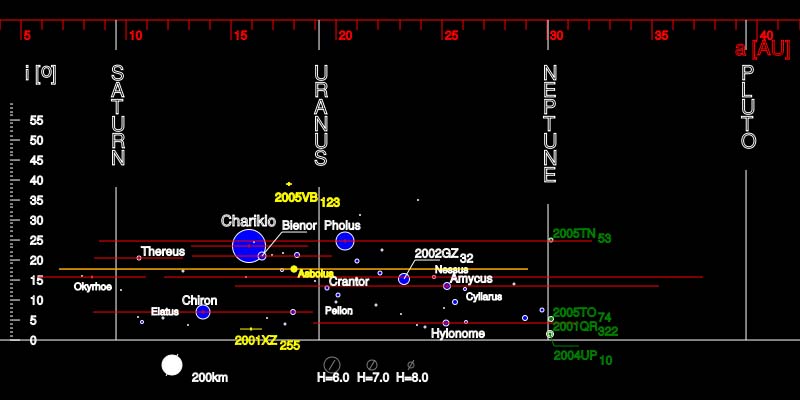

Asteroids Centaurs
The centaurs are a class of icy planetoids named after the mythical race of centaurs. Centaurs orbit the Sun between Jupiter and Neptune, crossing the orbits of the large gas giant planets. The first centaur to be discovered was 2060 Chiron in 1977.
The orbits of the centaurs are dynamically unstable due to interactions with the giant planets, so they must be objects in transition from a large, outer reservoir of small bodies, believed to be the Kuiper belt, to potentially active, comet-like inner solar system objects.
No centaur has yet been photographed up close by a spacecraft, although there is evidence that Saturn's moon Phoebe, imaged by the Cassini probe in 2004, may be a captured centaur. In addition, the Hubble Space Telescope has gleaned some information about the surface features of 8405 Asbolus.
Three centaurs, Chiron, 60558 Echeclus, and 166P/NEAT 2001 T4, have been found to display cometary comas. Chiron and 60558 Echeclus are now classified as both asteroids and comets.
For this reason last, it is possible to think that the Centaurs represent an area of transition between the rocky asteroids nearest to the Sun and the frozen objects and smaller density comet nucleus that travel in Neptune's orbit and beyond to the Solar System limit, like Neptune Trojans, KBOs and Oort's cloud objects.
2060 Chiron
Baptized with the name of the Centaurs most famous one, this planetoid was discovered by Charles T. Kowal in 1977 and it was the first known member of this new class of objects.
Now classified as asteroid and comet, (with comet designation 95P/Chiron) has 132 to 142 Km of diameter and spinning around the Sun in a very elliptic orbit with 1,264 million km in its nearer point (Perihelion) and 2,826 million Km in its far away point (Aphelion).
Composite chart with the identification and characteristics of known Centaurs and Trans-Neptunians. (WIKIPEDIA)

White name: Centaurs
Green name: Neptune Trojans
Yellow name: Centaurs with special features:
2005 VB123 has the most highly inclined orbit (~39°); curiously, its orbit is also quasi-circular (the lowest eccentricity < 0.01)
Asbolus has the most eccentric orbit (eccentricity=0.62)
2001 XZ25 has the lowest inclination (<3°).
Horizontal position: It marks the distance to the sun in Astronomical Units (red ruler at top)
Vertical position: Orbit inclination (white ruler at left)
Red horizontal lines: It marks the perihelion and aphelion of each object and the longitude represents the eccentricity.
Circles diameter: It marks the object diameter in kilometers and the magnitude according to the references at bottom (diameter: white disk, magntude: gray circles)
| Asteroids Centaurs data | ||||||
| Name | Distance to the Sun (AU) |
Mag. | Inclin. | Eccen. | Discovered by | Year |
| (52872) Okyrhoe | 8.388 | 11.3 | 15.6° | 0.309 | Spacewatch | 1998 |
| (60558) Echeclus | 10.77 | 9.5 | 4.3° | 0.456 | Spacewatch | 2000 |
| (8405) Asbolus | 17.974 | 9 | 17.6° | 0.62 | Spacewatch | 1995 |
| (31824) Elatus | 11.782 | 10.1 | 5.3° | 0.383 | CS. S | 1999 |
| (2060) Chiron | 13.685 | 6.5 | 6.9° | 0.382 | C. T. Kowal | 1977 |
| (32532) Thereus | 10.616 | 9 | 20.4° | 0.198 | NEAT | 2001 |
| (5145) Pholus | 20.431 | 7 | 24.7° | 0.572 | Spacewatch | 1992 |
| (7066) Nessus | 24.619 | 9.6 | 15.6° | 0.52 | Spacewatch | 1993 |
| (10199) Chariklo | 15.868 | 6.4 | 23.4° | 0.176 | Spacewatch | 1997 |
| (54598) Bienor | 16.468 | 7.6 | 20.8° | 0.201 | Deep Ecliptic Survey | 2000 |
| (55576) Amycus | 25.271 | 7.8 | 13.3° | 0.399 | NEAT | 2002 |
| (52975) Cyllarus | 26.096 | 9.3 | 12.7° | 0.378 | N. Danzl | 1998 |
| (49036) Pelion | 19.964 | 10.4 | 9.4° | 0.136 | R. J. Whiteley, D.J. Tholen | 1998 |
| (10370) Hylonome | 25.2 | 8 | 4.1° | 0.25 | D. Jewitt, J. X. Luu | 1995 |